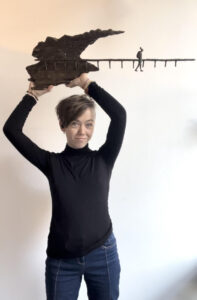Varvàra Fern is an artist on a journey. Her highly detailed bronze and resin-cast sculptures, which are featured in our current community exhibition, Walking the Edge, tell the stories of people taking their first steps along the path from unhappiness towards happiness, from imbalance towards inner peace. 
Varvàra was born and grew up in Russia, and before moving to the U.S., she studied at the Surikov Art Institute in Moscow. There, she learned composition and figurative sculpture, both of which she continues to utilize in her work today. It wasn’t until she visited the U.S., however, that she stumbled upon what would become her artistic inspiration for the next several years. When she was 13, Varvàra and her family drove from Albuquerque, New Mexico to New York City. On this trip, she traveled down highways, past bridges, and through deserts and wooded landscapes. She became, in her own words, “hypnotized” by these landscapes and by what marked the borders between them: signposts, lampposts, and telephone poles, for example. To Varvàra, these markers felt sculptural: she started to notice their structures, materials, and rustic color schemes.
A few years later and back in Russia, Varvàra came across the work of Mike Brodie, a photographer whose series “A Period of Juvenile Prosperity” and “Tones of Dirt and Bone” include poetic images of his travels. Varvàra describes feeling that these images were often emotional, encapsulating a sense of despair. She also watched YouTube videos of travel and train hopping across the United States.
Soon, Varvàra began translating her newfound interest in journeys and borders into complex sculptures. Her “Travel Series,” which she began at Surikov Art Institute in Moscow and continues today at Pennsylvania Academy of Fine Arts, involves a complex, multi-step process from inspiration to realization.
First, Varvàra forms an image in her head. While listening to music (typically acoustic music, like that of artist Gustavo Santolalla), she sculpts a small clay “sketch” to determine how she can translate her mental image into a physical object. When she’s happy with a sketch, she casts her work into resin or plaster. Next, she rebuilds and refines her sketch to create a detailed clay sculpture, then eventually, she casts her final piece. While Varvàra wanted to cast most “Travel Series” sculptures in bronze, she had to adapt quickly when bronze casting became less accessible during the start of the COVID-19 pandemic; she also found that bronze sculptures travel poorly. To be able to keep working, Varvàra developed a technique of painting resin to look like bronze. Today, her bronze and resin pieces are virtually indistinguishable.
In addition to her “Travel Series,” Varvàra has another body of work formed around a very different subject: bulldogs. When asked about her inspiration, Varvàra remarked, “If people ask if I’m a cat or a dog person, I say I’m a bulldog person.” Varvàra grew up with two bulldogs, and reflects that to her, bulldogs seem very “human” as a result of their emotionally expressive faces. She also likes how they scratch themselves on the floor (“as if they’re dancing”) and how, no matter where they are, they will fall immediately asleep.
As Varvàra continues along her own journey as a sculptor during and after her time at PAFA, she plans to continue playing with size, scale, material, and form. She wants to try out welding, to make a large-scale sculpture for “Travel Series”, and to explore new themes and topics, including her recent interest in representations of fairy tales.
Whatever her subject matter, it’s clear that Varvàra will continue creating sculptures that are thoughtful, clever, and reflective of the journeys we all take throughout our lives from place to place and experience to experience, as well as how we learn, grow, and change as we travel both in space and in spirit.
By Micah Lockman-Fine, Exhibitions Coordinator.
Artwork by Varvàra Fern.

